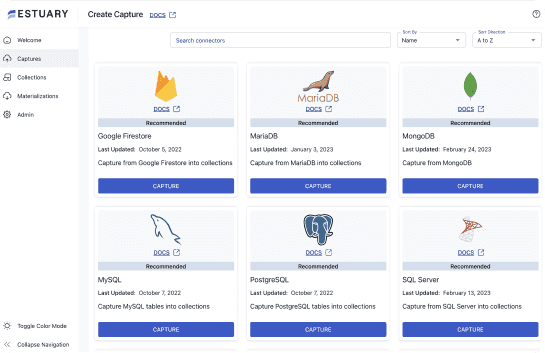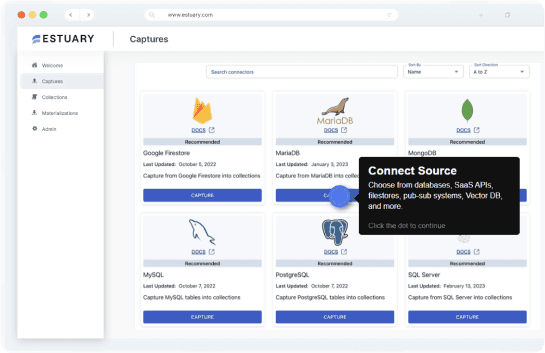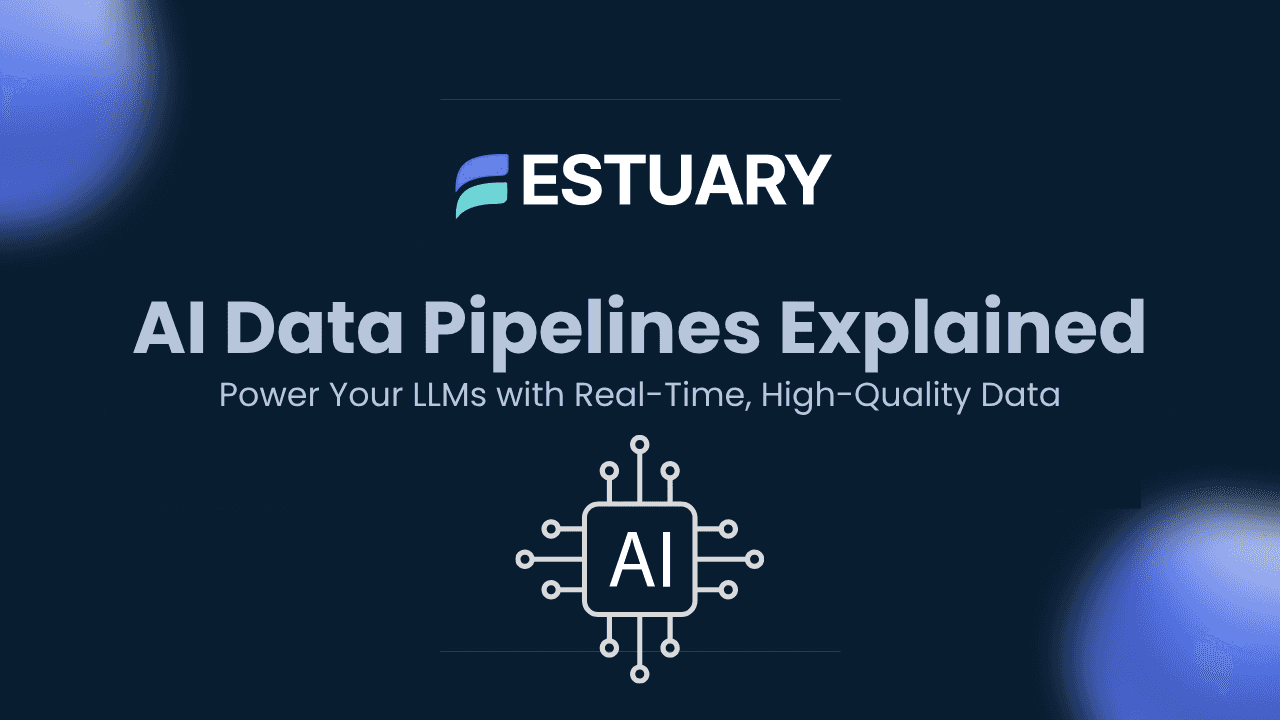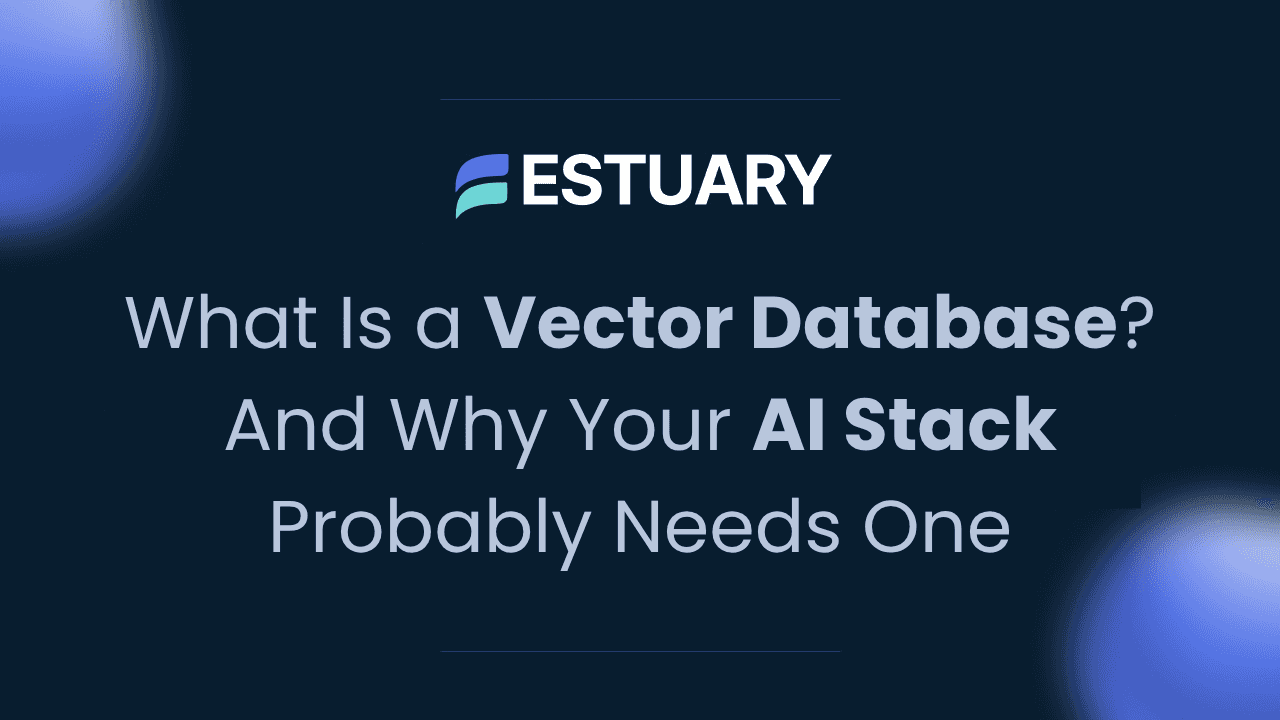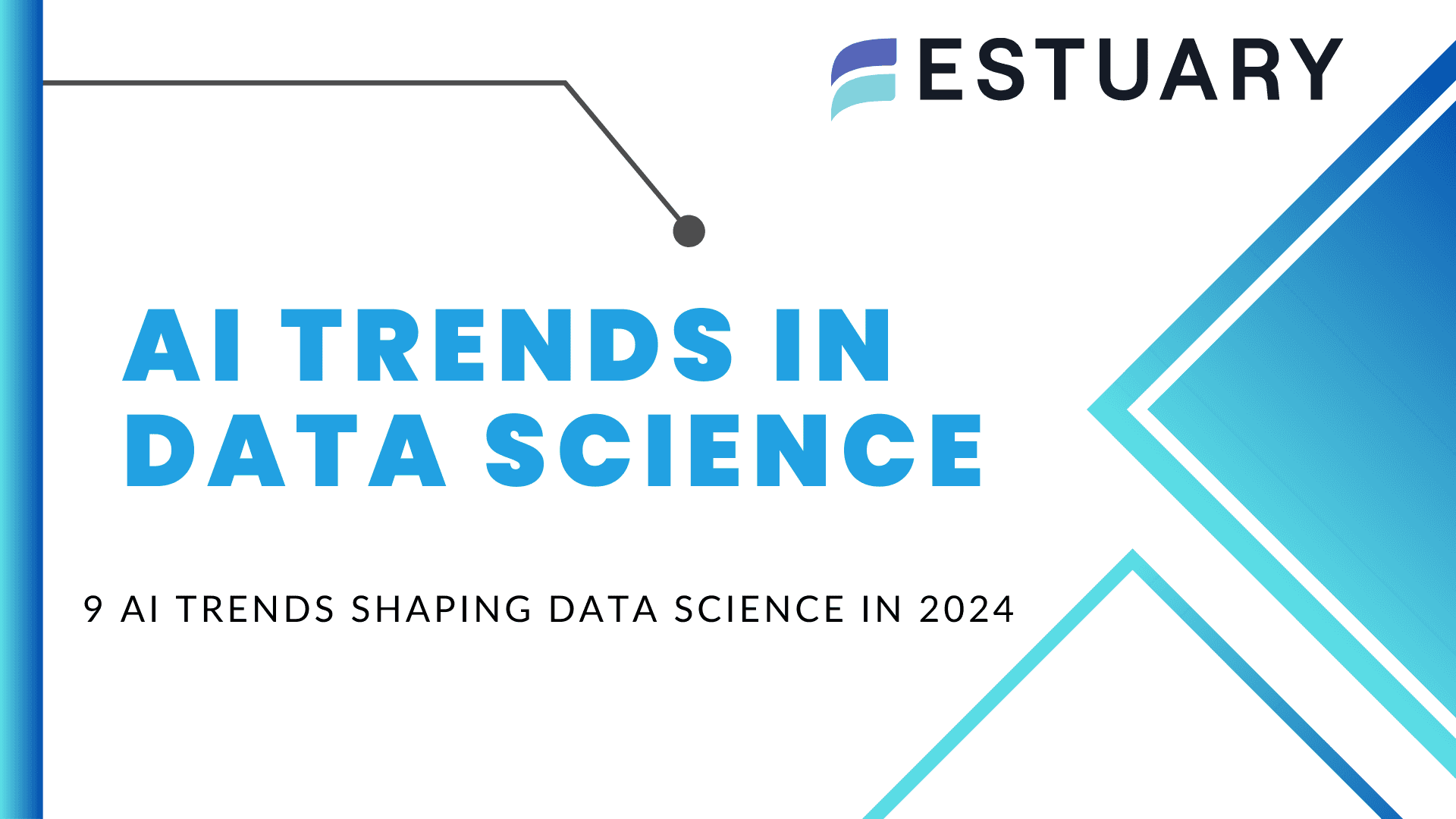
Introduction: Why AI Needs a New Kind of Data Pipeline
The future of AI is not just about smarter models. It is about delivering the right data at the right time.
Whether you're building a Retrieval-Augmented Generation (RAG) system, a personalized recommendation engine, or a chatbot that responds in milliseconds, your AI applications depend on data that is fresh, accurate, and context-rich. That level of performance is impossible without the right infrastructure beneath the surface.
Traditional ETL pipelines were built for a different era. They work in fixed batches, operate on scheduled intervals, and focus primarily on analytics dashboards. But AI workloads need more. They need pipelines that can handle semi-structured inputs like JSON or logs, respond to changes in real time, and continuously deliver data to downstream systems like vector databases.
This is where the AI data pipeline comes in. It is a new breed of data architecture that supports the speed, flexibility, and intelligence that AI demands.
AI pipelines are designed to continuously move and prepare data from operational systems like CRMs, databases, and SaaS tools into the core of your AI stack. They ensure that the data feeding your models is complete, consistent, and current.
In this guide, you will learn what an AI data pipeline is, what makes it different from traditional pipelines, and why real-time architecture is now a critical requirement for AI success. You will also see how platforms like Estuary Flow enable real-time, production-grade pipelines for any AI use case.
What is an AI Data Pipeline?
An AI data pipeline is a system that continuously moves and transforms data from source systems into formats that can be consumed by AI models. Unlike traditional ETL tools, which move data in periodic batches, AI pipelines are designed for real-time streaming, low latency, and high adaptability.
They form the connective tissue between raw data and AI outcomes.
At a high level, an AI pipeline performs four core functions:
- Ingesting data from multiple sources such as CRMs, databases, websites, or applications
- Transforming and enriching that data into a usable format
- Feeding the data into destinations like vector databases or feature stores
- Triggering AI systems to act on the updated data immediately
The purpose of this architecture is to ensure that AI models are never running on stale or incomplete data. Whether it's a chatbot that needs the latest customer records or a recommendation engine that must react to user behavior in real time, an AI pipeline makes sure your data is flowing, fresh, and aligned with the needs of your application.
Traditional pipelines focused on batch transformations and dashboarding. AI pipelines are built for continuous processing, event-driven logic, and multi-structured data, all of which are vital for use cases like:
- Retrieval-Augmented Generation (RAG)
- Semantic search
- Fraud detection
- Real-time recommendations
- Dynamic pricing
Modern platforms like Estuary Flow make it possible to build AI pipelines without code, using streaming-first infrastructure that is production-ready and easy to scale.
Most AI projects fail not because of poor models, but because of broken or outdated data.
The AI data pipeline fixes that.
Why Traditional Pipelines Fall Short for AI Workloads
Traditional data pipelines were designed for a world of dashboards, static reports, and daily refresh cycles. They served their purpose well for business intelligence, but when applied to AI workloads, their limitations become clear.
Here are the core reasons why legacy ETL and ELT tools struggle to support AI:
1. Batch Latency Is Too Slow
AI models often need to respond to real-world events as they happen. Batch pipelines that run every few hours or once a day introduce unacceptable delays. For AI use cases like fraud detection or real-time recommendations, even a few minutes of lag can break the user experience.
2. Inflexible Schema Handling
AI pipelines must handle messy, semi-structured, and rapidly evolving data. Traditional pipelines tend to be brittle. If the schema changes in your CRM or log stream, you may need to pause ingestion, reprocess data, or write manual transformations. That slows everything down.
3. No Support for Streaming Data
Batch pipelines work on snapshots. AI applications often rely on event-based updates and continuous streams of new information. Without true streaming support, you're forcing real-time systems to wait for yesterday’s data.
4. Difficult to Integrate with Vector Databases
Many AI pipelines end in a vector database like Pinecone or Weaviate. These systems power semantic search and RAG applications. Legacy ETL tools do not support native vector outputs, embedding generation, or continuous upserts into vector stores.
5. Limited Change Data Capture (CDC)
Capturing fine-grained changes from operational databases is crucial for keeping AI models in sync. Traditional pipelines often lack robust CDC, leading to data drift and model degradation.
Modern AI infrastructure demands more than what legacy pipelines can offer. It requires real-time, adaptable, schema-aware systems that can keep up with fast-moving data and downstream AI needs.
What Makes an AI Pipeline Different?
AI pipelines are not just faster versions of traditional data workflows. They are fundamentally designed for a different set of challenges — ones that come from working with large language models (LLMs), retrieval-augmented generation (RAG), and real-time personalization engines.
Here’s what sets AI pipelines apart:
1. Built for Real-Time from the Ground Up
AI data pipelines use streaming technologies that capture and deliver data in near real-time. Change Data Capture (CDC), event streaming, and push-based updates ensure that your AI models always operate on fresh, relevant data.
2. Handles Semi-Structured and Complex Data
AI workloads often require processing unstructured or semi-structured inputs like user queries, product reviews, or logs. Modern AI pipelines natively support formats like JSON, and apply schema-on-read or automated schema evolution to handle messy data.
3. Supports Embedding Generation and Vectorization
Unlike batch tools that stop at warehouse destinations, AI pipelines extend further into the model stack. They include steps for turning documents into embeddings using models like text-embedding-ada-002, and directly write to vector databases like Pinecone or Weaviate.
4. Continuous, Incremental Updates
AI pipelines avoid full reloads and instead stream only what’s changed. This is critical for performance, cost, and reducing hallucinations in LLMs. Incremental syncs ensure your retrieval layer always reflects the latest data state.
5. Integrates Seamlessly with the AI Stack
From PostgreSQL and HubSpot to Pinecone and OpenAI APIs, AI pipelines are built to connect the full data ecosystem that feeds into LLMs. Tools like Estuary Flow even allow materialization directly into your AI endpoints.
In short, AI pipelines are the connective tissue between your data sources and your models — optimized for freshness, flexibility, and scale.
The shift from batch ETL to real-time AI pipelines is not optional. It’s the new baseline for any production-grade AI system.
Key Components of an AI Data Pipeline
An effective AI data pipeline is made up of modular components that work together to ensure your models are always powered by accurate, high-quality data. Let’s walk through the major building blocks.
1. Data Ingestion
This is the entry point. Ingestion tools pull data from operational systems like Salesforce, PostgreSQL, or MongoDB. Modern ingestion must support both batch and real-time sources, with Change Data Capture (CDC) playing a key role in tracking and syncing updates.
Tools like Estuary Flow enable streaming ingestion with no-code configuration, making it easy to capture updates in real time.
2. Data Transformation
Once ingested, the data often needs to be cleaned, enriched, or restructured. This step may involve:
- Mapping fields
- Parsing nested JSON
- Calculating new values
- Filtering irrelevant records
For AI, transformations also include converting documents or objects into a model-ready format.
3. Embedding Generation
At this stage, the pipeline generates vector embeddings from textual or semi-structured data. This can be done using models like OpenAI’s text-embedding-ada-002, Cohere, or open-source alternatives.
The result is a high-dimensional vector that represents the semantic meaning of the input, ready for indexing in a vector database.
4. Vector Database Sync
The embeddings are streamed or batch-loaded into a vector database such as Pinecone, Weaviate, or pgvector. This layer supports semantic search, RAG applications, and other similarity-based retrieval tasks.
A well-designed pipeline handles:
- Incremental updates
- Metadata attachments
- Vector schema mappings
5. Orchestration and Monitoring
A production-grade pipeline needs built-in observability. That includes:
- Tracking which records have been processed
- Managing schema changes
- Handling retries and failures gracefully
- Auditing for compliance
These components must work together without friction to keep your AI stack performant, fresh, and trustworthy.
Real-Time AI Use Cases That Depend on Pipelines
AI is only as good as the data that powers it. And increasingly, that data needs to be fresh, contextual, and ready for inference in seconds, not hours. Below are some of the most powerful real-time AI use cases where data pipelines play a central role:
1. Retrieval-Augmented Generation (RAG)
LLMs are great at language, but not at remembering specific facts. RAG solves this by retrieving relevant documents from a vector database before the model responds. This architecture depends on continuously updated pipelines feeding fresh data into that retrieval layer.
Example: A chatbot that answers product or policy questions by referencing the latest documents, support logs, or CRM updates.
2. Personalization Engines
Real-time personalization — like recommending the right article, product, or offer — requires up-to-the-minute context about each user. Pipelines must capture behavioral signals and stream them into recommendation models instantly.
Example: A retail site adjusting product rankings based on a user's last click or purchase.
3. Fraud Detection
Spotting fraudulent activity is a race against time. Pipelines ingest transaction data, customer history, and device signals in real time so AI models can flag anomalies within milliseconds.
Example: Blocking a suspicious login or payment based on location mismatch or behavior patterns.
4. Content Moderation
Large platforms use AI to scan posts, comments, and uploads for toxicity, spam, or policy violations. These pipelines must process and vectorize data as soon as it appears to prevent harmful content from reaching users.
Example: Flagging a harmful comment on a livestream with zero lag.
5. Dynamic Pricing
Whether in e-commerce, travel, or ride-sharing, AI adjusts prices based on demand, competition, and user behavior. Feeding these models with real-time signals is essential for staying competitive and profitable.
These applications are not science fiction. They’re being built today and all depend on real-time AI data pipelines functioning behind the scenes.
Want to explore how Estuary Flow handles ingestion, embedding, and vector sync for use cases like these? Explore AI data workflows →
Designing an AI-Ready Data Stack
Building an AI data pipeline is not just about choosing tools. It’s about designing a resilient, flexible architecture that can grow with your use case. Let’s break down the core layers of a modern, AI-ready data stack.
1. Data Sources
Start with the systems that generate your data. These include:
- Operational databases like PostgreSQL and MySQL
- SaaS platforms such as Salesforce and HubSpot
- Logs, events, and clickstreams
Your stack should support pulling from all of these sources in real time.
2. Ingestion Layer
This is where the data enters your pipeline. It must:
- Support streaming ingestion (not just batch)
- Handle CDC (Change Data Capture) where possible
- Offer schema evolution and backfill capabilities
Tools like Estuary Flow provide these features natively, letting you capture inserts, updates, and deletes in real time.
3. Transformation and Embedding
After ingestion, data must be shaped and embedded. That includes:
- Data cleansing and enrichment using SQL or TypeScript
- Feeding cleaned data into embedding models like OpenAI or Cohere
- Generating vector representations with proper metadata
This step ensures your AI models receive contextually rich, model-ready data.
4. Storage Layer: Vector Databases
Once embedded, vectors are stored in a system optimized for similarity search. Options include:
- Pinecone
- Weaviate
- pgvector
- Qdrant
Your pipeline should handle incremental upserts and schema mapping automatically.
5. Serving Layer: AI Applications
At the top of the stack sit your user-facing applications:
- Chatbots
- RAG systems
- Personalization engines
- Fraud detection tools
They query the vector database or other storage layers to deliver intelligent responses.
Bonus: Orchestration and Monitoring
Your stack is not complete without visibility. Monitoring tools should track pipeline health, data latency, and schema drift, ensuring every component stays in sync and performs reliably.
Value Tip: Pipelines with exactly-once delivery guarantees prevent AI from acting on stale or duplicate data, a common source of hallucinations.
How Estuary Flow Powers Real-Time AI Data Pipelines
AI systems are only as good as the data they learn from. That’s where Estuary Flow comes in. It provides the real-time, schema-aware infrastructure needed to build robust AI pipelines—from ingestion to transformation to vector storage. Here’s how it fits into each critical stage of the AI data pipeline.
1. Real-Time Ingestion Across the Stack
Estuary Flow offers native Change Data Capture (CDC) support for high-volume databases like PostgreSQL and MySQL, along with API-based connectors for tools like HubSpot, Salesforce, and Notion. These connectors allow you to:
- Continuously stream structured and unstructured data
- Eliminate batch delays and stale inputs
- Maintain schema consistency with automatic evolution
Whether you’re syncing logs, CRM entries, or knowledge base content, Flow ensures the freshest data is always available.
2. Embedded Transformations for AI Readiness
Once data is captured, it often requires formatting, normalization, or enrichment. Estuary supports:
- SQL- and TypeScript-based declarative transformations for high flexibility
- Derivations for stream-based data processing
- Schema enforcement and validation before any downstream materialization
This built-in transformation layer reduces preprocessing overhead before embedding.
3. Real-Time Materialization into Vector Databases
Estuary Flow offers direct connectors to vector databases like Pinecone. These integrations enable:
- Real-time upserts of embedded data
- Support for OpenAI’s embedding models via automatic API integration
- Efficient handling of metadata and namespace separation
This is ideal for Retrieval-Augmented Generation (RAG), as demonstrated in Estuary’s real-time ChatGPT teaching pipeline.
4. Continuous Updates for Dynamic Context
With Flow, pipelines don’t stop once deployed. Any changes in the source data—new documentation, updated customer records, or corrected product information—are automatically captured and reflected in your AI systems within milliseconds.
This is essential for:
- Reducing hallucinations in LLMs
- Improving contextual recall in chatbots and assistants
- Keeping RAG responses aligned with reality
5. No-Code + Enterprise Grade
Flow supports both managed cloud and Bring Your Own Cloud (BYOC) deployments. You get:
- Easy setup via a modern web UI
- CLI support for automation and testing
- Compliance-ready, scalable architecture
From proof of concept to production-scale pipelines, Estuary Flow gives data teams the tooling they need to reliably fuel AI applications.
Conclusion: AI Pipelines Start with Smart Data Infrastructure
As AI adoption accelerates across industries, data pipelines have become mission-critical. These pipelines serve as the connective tissue between raw data and AI models, enabling everything from basic predictions to advanced Retrieval-Augmented Generation (RAG) applications.
A strong AI data pipeline isn't just about moving data — it's about moving the right data, in real time, in a format your models can use. This means syncing sources continuously, transforming inputs for embeddings, and delivering them into fast, queryable stores like vector databases.
Estuary Flow helps you do exactly that. Whether you're building an intelligent chatbot, powering semantic search, or enriching an LLM with real-time context, Flow gives you the tools to unify, clean, and deliver data with sub-second latency.
Ready to Build Your AI Data Pipeline?
Explore Estuary Flow and see how easy it is to connect data sources, transform data in motion, and sync to vector databases like Pinecone — all in real time.
FAQs
What tools are used to build AI data pipelines?
Can I use my existing data warehouse in an AI pipeline?

About the author
Team Estuary is a group of engineers, product experts, and data strategists building the future of real-time and batch data integration. We write to share technical insights, industry trends, and practical guides.

